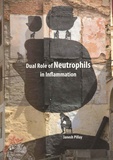Dual Role of Neutrophils in Inflammation

Pillay, Janesh
- Promoter:
- Prof.dr L. (Leo) Koenderman & prof.dr L.P.H. (Loek) Leenen
- Research group:
- Koenderman
- Date:
- November 10, 2011
- Time:
- 14:30 h
Summary
Systemic inflammation is a hallmark of trauma, sepsis and various severe infectious diseases. Severe systemic inflammation can lead to inflammatory complications. The Acute Respiratory Distress Syndrome (ARDS) and Multiple Organ Dysfunction Syndrome (MODS) are seen after trauma and in sepsis and are accompanied by a high mortality and morbitidy. These complications are mediated by a hyperactive immune system. On the other hand, immune suppression is frequently seen following systemic inflammation. This leads to susceptibility to infections, or an inability to contain or clear infections. Increased pathogen load might lead to hyperactivation of the immune system and therefore result in tissue damage and organ failure. It has been established that neutrophils play an important role in tissue damage due to immune activation. However, the role of neutrophils in immune suppression following systemic inflammation is unclear. Neutrophils have long been considered to be a homogenous population of short-lived innate immune cells. In this thesis we show that, by using an in vivo labeling technique, neutrophils have a circulating half- life almost 10x longer than previously reported. We used a human model of endotoxemia to study the effects of systemic inflammation on the neutrophil population. Circulating neutrophil phenotypes between human endotoxemia and trauma were strikingly similar. In systemic inflammation multiple neutrophil populations appear in the circulation. Hypersegmented neutrophils are capable of suppressing T-cell responses and banded neutrophils show decreased phagocytosis of bacteria. This shows that multiple functionally different neutrophil populations exist in inflammation. In addition, immune suppression by neutrophils can be achieved by multiple mechanisms. Firstly, release of immature neutrophil forms results in downregulation of their anti-microbial functions. Secondly, neutrophils are capable of directly suppressing T-cell responses by creating an immunological synapse and direct delivery of hydroperoxide. In systemic inflammation all neutrophil populations are primed (pre-activated) for the release of extracellular ROS. This shows that to a certain extent that these neutrophils are still capable of tissue damage. Limiting systemic inflammation might limit both neutrophil mediated tissue damage and neutrophil mediated immune suppression. Neutrophil-endothelial interactions are necessary for neutrophil migration to tissues. In inflammation, fibrinogen behaves as an acute phase protein and increases to suprafysiological concentrations. These concentrations are not needed for normal coagulation. In vitro studies showed acute phase concentrations of fibrinogen were able to limit neutrophil adhesion to vascular endothelium and activation. For limiting in vivo inflammation we studied C1-esterase inhibitor (C1inh). C1inh was able to limit systemic inflammation following LPS administration in humans. Therefore we conclude that neutrophils display dual roles in inflammation, contributing to tissue damage and immune suppression. Limiting systemic inflammation might limit inflammatory complications attributable to tissue damage and immune suppression. Acute phase proteins such as fibrinogen and C1inh might be promising interventions to achieve this.